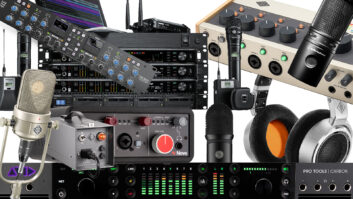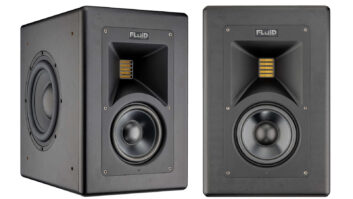
When Universal Audio reissued the vintage LA-2A Leveling Amplifier eight years ago, I was one of the first people to open my wallet. The LA-2A featured the all-important T4 electro-optical cell responsible for the ultratransparent compression heard on countless hit records. Unfortunately, the LA-2A also required a kludgey procedure to stereo-link two units: A shielded wire less than two feet long had to be connected to two screw terminals on the back of each unit, followed by a stereo-calibration procedure.
The new 2-LA-2 offers two LA-2A-style compressors mounted side-by-side in a two-rackspace chassis. You can link them for stereo operation with the throw of a switch. How sweet it is.
LIKE FATHER, LIKE SON (NEARLY)
The 2-LA-2 is not an exact component clone of the LA-2A; rather, it substitutes modern parts such as metal film resistors and newer caps in its bequeathed Class-A circuit layout. The 2-LA-2 uses the same input transformer as the LA-3A and the same output transformer as the one used in the 610 series of products. The 2-LA-2 offers far greater headroom as compared to the LA-2A, which puts mix bus applications into play.
A T4 opto cell in each channel’s sidechain gives the 2-LA-2 its pedigreed 10ms attack time and two-stage release (0.06 second for 50-percent release and 0.5 to five seconds for the remainder, depending on program content). Four tubes — two 12AX7As, one 12BH7A and one EL84 — grace each channel.
Front panel controls are identical for each channel. Operation is so simple, a goldfish could handle it. Simply turn the Peak-Reduction knob clockwise to increase compression depth and do the same to the Gain control to add make-up gain. There are no attack and release controls; time constants are program-dependent. One switch selects between compression and limiting, while another causes the channel’s Sifam VU meter to show either gain reduction or output level. A recessed trim pot zeroes the meter. There are switches to select stereo-linked or dual-mono operation. Another switch bypasses compression while leaving the tubes in-circuit for coloring input signals without compressing them. But it also makes A/B comparisons between compressed and uncompressed signals difficult because of level changes for each setup. Balanced XLRs on the rear panel provide line-level I/O connections for each channel. Inserts for the sidechains are not provided.
SQUEEZE ME, BABY
My first test was an A/B comparison between the 2-LA-2 and my LA-2A on male vocals. The LA-2A preserved a tad more air, resulting in a slightly clearer and more detailed sound. The timbral difference was subtle. Most importantly, the compression characteristics sounded identical and entirely devoid of any amplitude-modulation artifacts with 10 dB of gain reduction applied. The 2-LA-2 can reign in even the most unruly vocals.
Next up were double-tracked electric guitars, hard-panned and recorded with Royer R-121 and Shure SM57 mics. For this application, the 2-LA-2’s dual-mono mode gave a wider stereo image than stereo linking. I dialed in 2 to 5 dB of gain reduction in Compression mode, listened and smiled. The guitarist’s fully voiced chords were transparently squeezed so that palm-muted diads peppering his playing were raised roughly 3 dB in relative level. The result was a driving, rhythmic onslaught that sounded absolutely phenomenal. Compared to the unprocessed tracks, the processed sound was also slightly creamier. Compression mode lent a pluckier sound (exhibiting more detailed transients) than Limit mode.
On an acoustic guitar that I recorded with a spaced pair of Neumann KM184s, applying 2 to 3 dB of gain reduction produced a beautifully dense track somewhat reminiscent of early CSNY productions. On both stereo acoustic guitar and piano, the stereo-link function provided the most rock-solid imaging. Dual-mono mode provided a wider stereo spread but made the center image slightly wobbly, even with only 2 dB of gain reduction. Nevertheless, I sometimes preferred dual-mono mode when I desired some shimmering movement in a stereo instrument during mixdown.
With light to moderate compression of stereo tracks, the 2-LA-2 is as transparent as Saran Wrap™. Crank the Peak-Reduction control, however, and you can make percussive tracks hyperventilate like a marathon runner. In dual-mono mode, the 2-LA-2 made drum overheads and room mics pump beautifully with 7dB gain reduction applied. The processed sound also added flattering density, and made crash and ride cymbals sound a little less icy.
The 2-LA-2 sounded great placed on the stereo bus during mixdown as long as I didn’t push its I/O levels too hard. Specs for the unit rate maximum input at +24 dBu and output as +20 dBu, nominal for 1-percent THD, which is fairly modest. The unit can catch transients quickly enough that I could readily make my rock mix louder. The 2-LA-2 also added subtle warmth and creaminess, and a beautifully tightened bottom end. If I pushed the levels too hard, however, then the mix started to sound a little gritty.
I’LL LEVEL WITH YOU
The 2-LA-2 sounds its best — make that fantastic — on individual mono, dual-mono and stereo tracks. At $3,999 list, such quality doesn’t come cheaply. But if you’ve got the dough, you’ll love what Universal Audio has cooked up.
Universal Audio, 877/MY-UAUDIO, www.uaudio.com.
Mix contributing editor Michael Cooper is the owner of Michael Cooper Recording in Sisters, Ore. Visit him at www.myspace.com/michaelcooperrecording.







